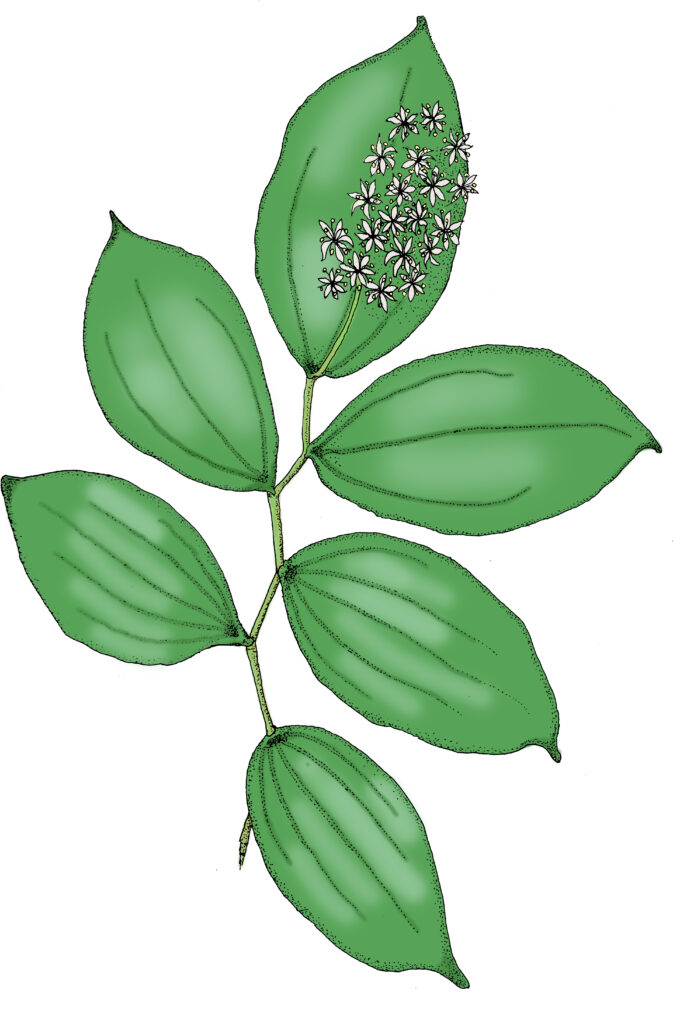Originally published in the Winter 2022 issue of the newsletter of the Kansas Native Plant Society.
It started with seed collection. Throughout this past spring, summer and fall, I’ve been collecting seed for propagation of native seeds, seeds to be shared with the Dyck Arboretum, and seeds for our prairie restoration. So when I gazed out the window earlier this fall and noted the scarlet berries of False Solomon’s Seal hanging from spent stems, I collected them. I’ve never propagated this species from seed, so clearly, research needed to be done. In that process, I’ve learned more about False Solomon’s Seal, and I’ve also come to more fully appreciate it!
False Solomon’s Seal
Maianthemum racemosum (formerly Smilacina racemosa)– is an herbaceous perennial, native to woodlands throughout North America. The common name reflects its similarity to Solomon’s Seal, but False Solomon’s Seal is easily distinguished by the flowers and later berries that are produced at the ends of the stems. Indigenous people have variously used the spring shoots, rhizomes and leaves for medicinal and food purposes; and deer will also browse on it.
In spring, this plant’s stalks emerge from fleshy rhizomes. Stems are slightly zigzag and grow from 18 – 36 inches in length. Leaves are smooth and alternate with parallel venation. In late spring, up to 80 feathery, quarter-inch flowers are produced at the ends of the stems. The flowers are characteristic of the lily family, having six tepals (look-alike petals and sepals), with six stamens surrounding the central pistil. They are fragrant and attract a variety of pollinators including small native bees, flies and beetles. The berries that form contain a few seeds each. Initially they are green with purple spots, ripening to crimson. Birds and mice disperse the seeds after eating the berries and eliminating the the seeds elsewhere.
How to Propagate
False Solomon’s Seal prefers moist, rich, well-drained soils and full to partial shade. The fibrous roots can be divided and transplanted, but it takes several years to fully reestablish in a new location. When grown from seed, False Solomon’s Seal can be sown directly into the soil in autumn for spring germination in a year or two. When propagating indoors, seeds require several rounds of alternating warm (room temperature) and cold (35 – 40 F) moist stratification before planting in pots. Here again, germination may take up to two years. Patience should definitely be included as part of the seed propagation protocol for this species!
The False Solomon’s Seal I planted nearly 20 years ago has flourished along the western side of the house. It receives light shade most of the day, but it also gets blasted by late afternoon summer sun, demonstrating this species’ ability to also tolerate drier, more exposed conditions. Over the years, the False Solomon’s Seal bed has filled in and reliably produces panicles of creamy white flowers each spring, graceful arching foliage in summer and bright red berries in fall; and it continues to serve as an elegant companion plant for Jack-in-the-Pulpit (Arisaema triphyllum), columbine (Aquilegia canadensis), prairie phlox (Phlox divaricata), wild ginger (Asarum canadense), and yellow violets (Viola pubescens). Slow starter though it is, False Solomon’s Seal is hearty, pollinator- and wildlife-friendly, easy to care for, long-lived, and attractive throughout the growing season – perfect for your native shade garden!
References
https://hort.extension.wisc.edu/articles/false-solomons-seal-maianthemum-racemosum/
https://www.mountroyalseeds.com/product/maianthemum-racemosum-false-solomons-seal/
https://plants.usda.gov/home/plantProfile
https://www.wildflower.org/plants/result.php?id_plant=marar

